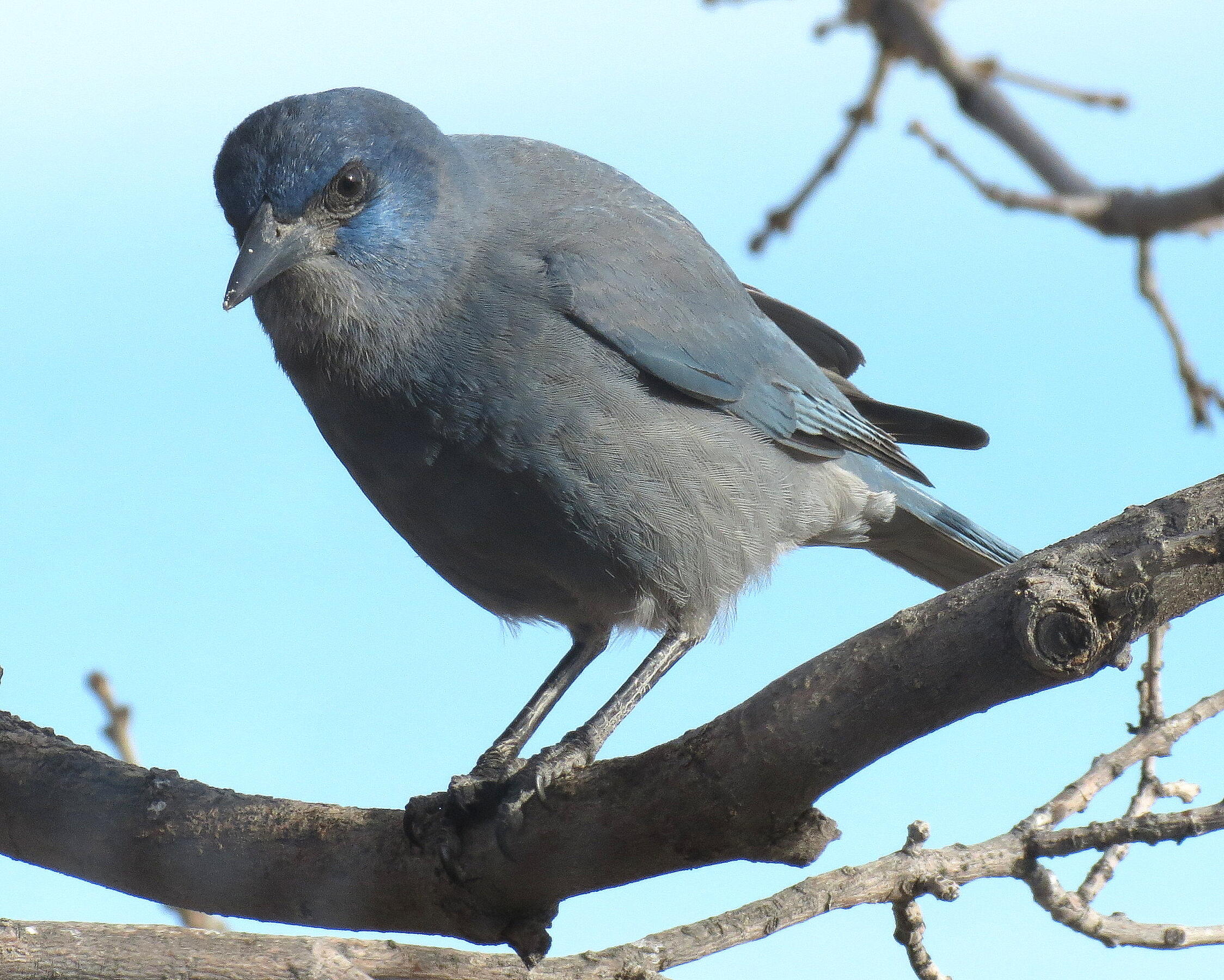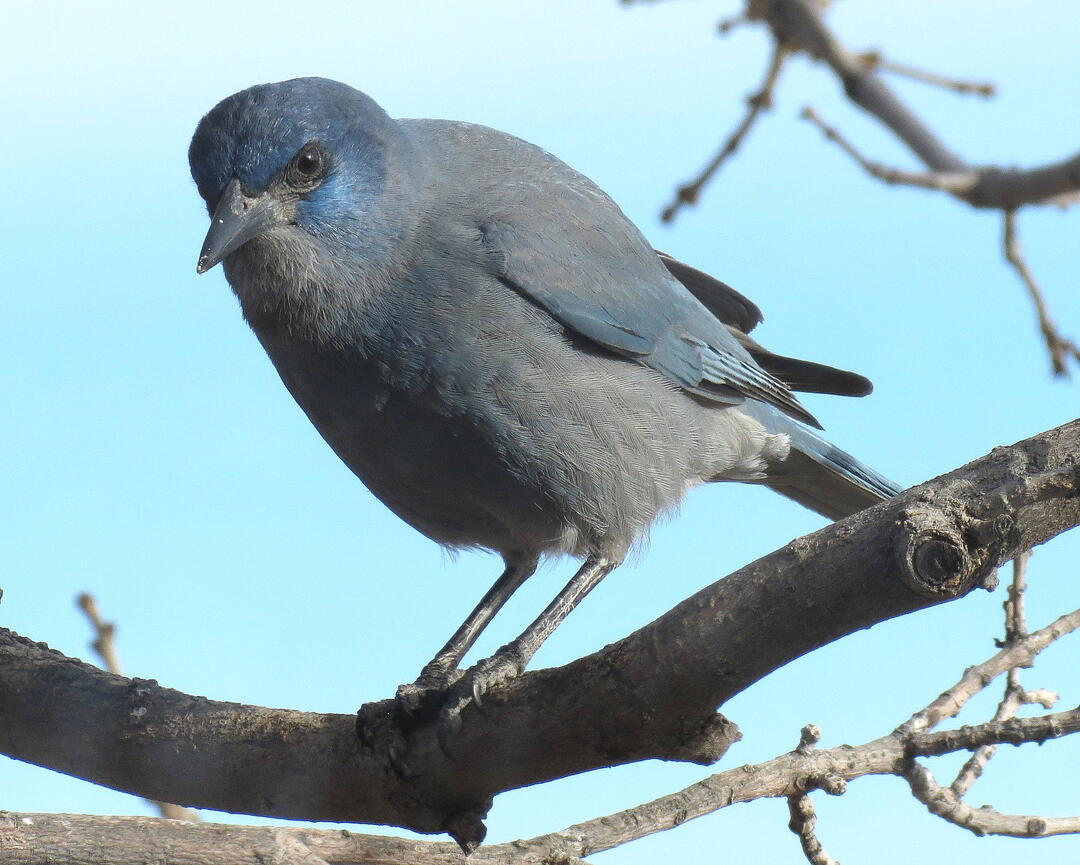It was a picture-perfect Colorado Plateau day…until the mountain bike brakes failed.
Crumpled in an uninjured heap, I can feel my teenage son glowering down as he kindly suggests that I walk the bike back to the car. While I dust off, he offhandedly reports that he heard “those laughing birds” and I perk up! Before I can probe further, he rolls off at high speed and I begin my “walk of shame” back to the trailhead. I am now on high alert for a flash of blue or tell-tale vocalizations.
The call of the Pinyon Jay (Gymnorhinus cyanocephalus) can be likened to a plaintive “Ha Ha Ha Ha” but unfortunately their status is no laughing matter. Long term drought, climate change, and habitat conversions have resulted in astonishing Pinyon Jay population declines. From 1967–2015, populations fell by an estimated 83.5%, and further losses seem imminent. Considered an obligate resident of Pinyon Juniper woodlands and adjacent shrub/grasslands throughout the intermountain west, this intelligent and raucous corvid has long captivated humans.
Highly colonial, flocks of several hundred birds were impossible to ignore in their foraging flights. Known colloquially as the “Blue Crow”, this corvid had little use for farm fields, passing over them in search of piñon. Piñon nuts are full of fat and protein—nutritious for both birds and mammals—and they are heavy, so the tree relies on animal transport for reseeding. The trees’ second strategy for continued survival is to produce seeds on a schedule that includes “mast years” in which there is such an overabundance of nuts that even all the hungry birds and animals cannot consume them. Pinyon Jays cache seeds in the ground, and those that are not retrieved might become baby trees. People long ago learned that the jays knew the best nut trees and had some insight into the trees’ unwritten production schedule.
Recent decades have seen unprecedented rates of change in climate, rainfall, and land use regimes. Our arid west has become more so while temperatures ramp up. Precious grasslands suffer shrub encroachment due to grazing pressures and invasive plant establishment, and meanwhile trees are stressed by drought and pests. All is not doom and gloom, but land managers are operating in unprecedented times, and need to protect both grasslands and forests all with an eye to fire safety. In the case of the Pinyon Jay, data is badly needed, and it is needed across the birds’ considerable range, especially in New Mexico, Arizona, Utah, and Nevada. We need to identify stronghold areas for the birds and to document historically occupied areas that are now devoid of jays. Future studies will key in on the piñon trees found in the areas now favored by the jays. What circumstances make these trees different and better able to thrive under current duress? Perhaps there are other variables that are commonalities in currently occupied areas. We need to look, and we need to do it right now. Please consider helping us!
The Great Basin Bird Observatory (GBBO) recognized Pinyon Jay declines early, and they were instrumental in forming the multi-agency Pinyon Jay Working Group. As early as 2007, GBBO took on focused studies to better understand Pinyon Jay natural history and devised an idea with a scaffold for innovative community science involvement. Pilot projects were run first with Lahontan Audubon Society in NV and in 2021 with Northern Arizona Audubon Society. Audubon Southwest joined the party in 2022 and we are all in!
We like our beer here at Audubon Southwest, and recently we’ve been turned on to craft mead! Spoiler alert: Western Rivers Brewers Council members Bosque Brewing in NM and Drinking Horn Meadery in AZ are poised to brew craft beverages this summer and to raise awareness of the Pinyon Jay plight and encourage engagement. More about that later!
On my embarrassing trek to the car, broken bike in tow, I heard them. Seven calling Pinyon Jays came flying across my trail. They looked like hope. And that’s what you look like to birds.
Reasons You Should Seriously Respect Pinyon Jays
- Gymnorhinus cyanocephalus = “naked nose, blue head” They are the only corvid with un-feathered nostrils, an adaptation that allows them to probe sappy cones neatly.
- They are truly monogamous. Despite researchers trying to get them to cheat!
- They can fit up to 56 piñon nuts in their sublingual (under tongue) pouch
- They remember and recover 95% of the seeds they cache
- Nesting is synchronized and last years’ young help rear babies
- Due to their high intelligence, they are VERY difficult to catch






